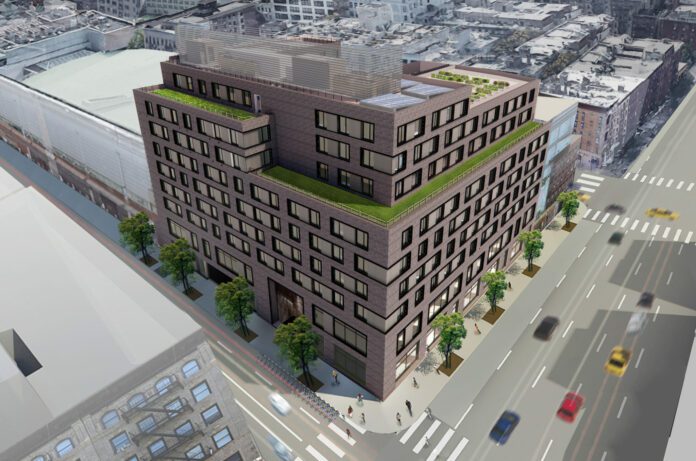Located in Hell’s Kitchen in Manhattan, the Lirio offers unique, affordable housing for HIV/AIDS survivors. This area of the city has the highest concentration of residents who have HIV, as well as one of the highest rates of new infections of HIV/AIDS. The project is set to be completed in 2023 but is facing some opposition from neighborhood leaders.
About The Lirio
Named for the oldest living thing in New York City, the liriodendron tree, the Lirio will feature 112 affordable homes, 59 of which offer support services for long-term survivors of HIV/AIDS or those with mental illness or substance abuse disorder. It will also include 44 permanently affordable homes for families and eight for formerly homeless people. The affordable homes are intended for families with household incomes from 40-80 percent of the area median income (AMI). Designed by the award-winning architecture firm, CetraRuddy, the Lirio is aimed at Passive House standards for energy efficiency.
Developed by the real estate firm Hudson Companies, Inc. and Housing Works, a non-profit organization that fights AIDS and homelessness, the project will be located at 806 Ninth Avenue at 54th Street, at the site of a current MTA parking lot.
Maria Torres-Springer, Deputy Mayor for Economic and Workforce Development stated that “The Lirio is a critical project to help address affordable housing needs in Hell’s Kitchen and support long-term survivors of HIV/AIDS—and a great example of how we make New York a ‘City of Yes’ for everyone.” The housing aims to meet the needs of the community by providing much-needed services.
Amenities at The Lirio
In addition to important services for those who need them, The Lirio will have approximately 30,000 square feet of office space for the MTA and around 9,000 square feet of retail space. It will also include sustainable features such as solar power, green roofs, high-performance building envelope, and VRF HVAC.
Pushback from the Surrounding Community
Those in the support of the project, such as HIV/AIDS advocates and survivors, say that such a facility is needed in the area and would greatly benefit those in the community who have suffered. Supportive housing like this is necessary to help individuals with HIV/AIDS to maintain their medical needs.
But not everyone is in agreement that this is a good move for the area. Some residents are pushing back against it and say the units are too affordable and want to maintain the neighborhood’s character. Members of Community Board 4 voted against the project in March, claiming it should be reserved for middle-income families. This is an unusual move for Community Board 4, which normally votes to support the construction of new housing units.
Those against the project have been vocal for the need for more middle-class housing. Real estate rents have gone up more than 30 percent from the year prior, according to data provided by RentHop. Currently, the median 1 bedroom rent in Hell’s Kitchen sits at about $4,295.
Richard Marans, a founder of the West 47/48th Block Association, stated during a March 2 meeting that “We don’t want a neighborhood that is all poor and all rich.” With rising rents, it has been difficult for middle-class families to be able to afford to live in this neighborhood.
The community board wrote a letter to city officials giving several options for approval, including changing the building’s façade to match those along Ninth Avenue as well as increasing the affordability bracket so the building has up to 25 percent of the units at 80 percent of the AMI and the rest between 80 and 165 percent.
Using information from the city for other affordable housing residences, one-bedroom units would then rent for $2,002 at 80 percent of the AMI. At 165 percent of the AMI, one-bedrooms could go for $4,129 per month.
In Hell’s Kitchen, the median household income is $90,422, according to data from the census. That means the maximum rent a household should pay is $2,250, about half of the 165 percent AMI percentage that some of the Community Board 4 members want.
Project Supporters Push Back
While these concerns are not unfounded, and the area does also need more middle-income housing, supporters feel that it should not be at the cost of providing supportive housing for those with HIV/AIDS. Residents can support the project and still campaign for more affordable housing for the middle class, supporters argue, particularly because this neighborhood could benefit greatly from this type of housing. Zoning
Proponents also feel that supportive housing would be a big improvement over the current parking lot. They claim that there is space available for mixed-income housing down the road in the area which should not affect the approval of The Lirio.
Next Steps for The Lirio
Before being allowed to break ground on the Lirio, its developers must win a rezoning through the Uniform Land Use Review Procedure, which involves the community board, the Manhattan Borough President, and the City Planning Commission. It also requires the approval of the local city council member for Hell’s Kitchen, Erik Bottcher.
Whether or not the Lirio receives approval to move forward, the issue brings to light the need for lower-income/supportive housing as well as middle-income housing in many New York City neighborhoods. While this is a goal of the current NYC mayor and administration, rising rents have affected New Yorkers faster than enough affordable housing can be created.
Lara Popeck has been writing for over 10 years, with a focus on business and real estate-related articles. She has a degree in Economics from Bryn Mawr College and an MBA from Montclair State University.



